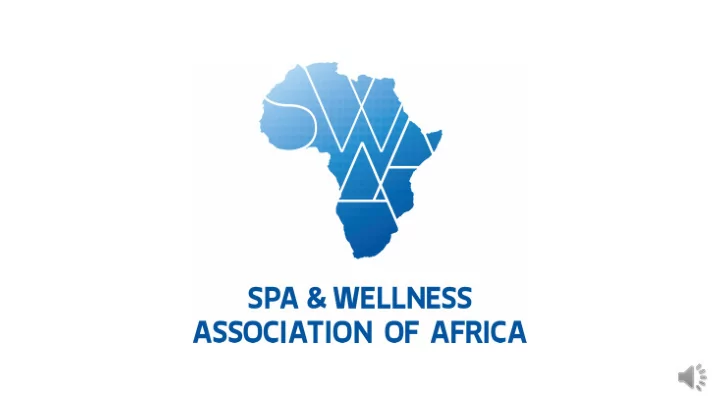

COVID-19 hygiene update Outline of presentation: • Overview of COVID-19 • International impact • Workplace and staff risk assessment guidelines • Workplace controls • Hygiene overview in the spa and salon • Safety measure guidelines
Overview of COVID-19 Coronavirus disease-19 (COVID-19) is caused by Severe Acute Respiratory Syndrome Coronavirus 2 (SARS CoV-2 virus) World Health Organization declared Coronavirus disease-19 (COVID-19) a pandemic on 11 March 2020 There is currently no vaccine Image 1. Illustration of the coronavirus (Van Elsland and Wighton, 2020).
Overview of COVID-19 Viral shedding occurs during asymptomatic state of the host Respiratory virus transmitted via respiratory droplets in salivary and mucosal excretions of the host including breathing, coughing and sneezing Contraction of the virus occurs in the mucosal membranes of the mouth, nose and eyes of another potential host Droplets that come into contact with human host is readily transmitted to site of entry Droplets remain active in airborne and on inanimate surface areas for a number of hours reportedly sometimes for days
International impact Image 2: World Health Organisation global confirmed COVID-19 cases (World Health Organisation, 2020)
Workplace and staff risk assessment guidelines Classification of worker exposure: Very high High Medium Low exposure risk exposure risk exposure risk exposure risk High potential for High potential for Close and frequent Do not require contact exposure to known or exposure to known or contact with people who with known or suspected sources of suspected sources of may be infected with suspected infection with COVID-19 COVID-19 SARS CoV-2 SARS CoV-2 Healthcare workers Workers exposed to Healthcare workers performing aerosol- public who is n ot Minimal occupational Entering into patient generating procedures known or suspected of contact with public and rooms and and collecting or being COVID-19 other co-workers transporting handling specimens patients
Workplace controls Evaluate Workplace Monitor Communicate controls Implement and execute
Workplace controls • Isolates employees from work related hazards without relying solely on employee behaviour • Installing face shields as physical barrier, increasing ventilation rate and high-efficiency air filters Engineering controls • Actioned by employer and employee • Up to date education and training in appropriate language and for all literacy levels on COVID-19 and the correct use of personal protective equipment (PPE) Administrative measures • Administrative controls that include procedures for safety and reducing possibility of duration, frequency or intensity of exposure to the hazard • Providing correct resources and promote personal and workplace hygiene • Safe workplace practice • PPE is the implementation control of safe work practice provided by the employer to minimise the risk of exposure to the hazard • Disposable nitrile gloves, cloth masks or disposable masks with face screen, disposable gowns, disposable shoe covers • Personal protective • PPE must be regularly inspected, maintained and replaced, cleaned, stored or disposed of equipment • Supplied by employer to enable employee to perform duties safely (PPE)
Hygiene overview in the spa and salon – key terms TERM DEFINITION • Total removal / destruction of all living micro-organisms. Sterilisation • Achieved by heat (e.g. steam) or chemicals (e.g. gluteraldehyde). • The process whereby objects are rendered clean and relatively germ free . Sanitation • A chemical agent which destroys micro-organisms but not usually bacterial spores • Doesn’t necessarily kill all micro -organisms, but reduces them to a state which is neither harmful Disinfectant to health nor the quality of perishable goods • Used for inanimate objects and materials, sometimes for the skin/body membranes • A non-toxic, non-irritant chemical agent which destroys or inhibits micro-organisms on living Antiseptic tissue , having the effect of limiting or preventing the harmful results of infection • Destruction of viruses by a chemical agent Virucide
Hygiene overview in the spa and salon (cont.) The WHO recommends the use of Ethyl Alcohol or Sodium Hypochlorite for surface disinfection as it denature proteins Liquid sterilant: Gluteraldehyde in an alkaline solution has been proven to be an effective, non-corrosive liquid sterilant for implements It is important to use all disinfectants and sterilants according to manufacturer’s instructions Use of reputable suppliers USA EPA N-list https://www.epa.gov/pesticide-registration/list-n-disinfectants-use-against-sars- cov-2
Safety measure guidelines Safety first in a hands on industry • Regular and effective disinfection of contact surfaces • Virtual pre-entry consultations • Disclaimers for guests as well as staff • PPE for staff and guests • Visual aids to promote safe work practice
THANK YOU
BIBLIOGRAPH Y World Health Organization. 2020. Getting your workplace ready for COVID-19 . Available at: https://www.who.int/docs/default-source/coronaviruse/getting-workplace-ready-for-covid-19.pdf [Accessed: 28 April 2020]. Republic of South Africa. Department: Employment and Labour. COVID-19 Workplace preparedness guide. Available at: http://www.labour.gov.za/DocumentCenter/Publications/Occupational%20Health%20and%20Safety/COVID- 19%20Guideline%20Mar2020.pdf. [Accessed: 28 April 2020]. Centers for Disease Control and Prevention. 2008. Chemical Disinfectants: Guideline for disinfection and Sterilization in Healthcare facilities. Available at: https://www.cdc.gov/infectioncontrol/guidelines/disinfection/disinfection- methods/chemical.html . [Accessed: 28 April 2020]. Centers for Disease Control and Prevention. 2020. Use of face coverings to help slow the spread of COVID-19. Available at: https://www.cdc.gov/coronavirus/2019-ncov/prevent-getting-sick/diy-cloth-face-coverings.html. [Accessed: 28 April 2020]. World Health Organization. 2020. Virtual press release on COVID-19 – 11 March 2020 . Available at: https://www.who.int/docs/default-source/coronaviruse/transcripts/who-audio-emergencies-coronavirus-press- conference-full-and-final-11mar2020.pdf?sfvrsn=cb432bb3_2. [Accessed: 28 April 2020]. United States: Environmental Protection Agency. 2020. List N Disinfectants for Use Against SARS-CoV-2 Pesticide Registration US EPA. Available at: https://www.epa.gov/pesticide-registration/list-n-disinfectants-use-against-sars-cov- 2. [Accessed: 28 April 2020]. Van Elsland, S.L. and Wighton, E. 2020. Two thirds of COVID-19 cases from mainland China may be undetected . Imperial College London . 22 February. Available at: https://www.imperial.ac.uk/news/195564/two-thirds-covid-19- cases-exported-from/. [Accessed: 28 April 2020].
Recommend
More recommend